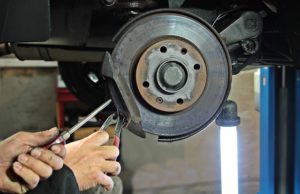 Large companies depending on various types of machines in their manufacturing processes recognize regular maintenance is crucial. Successful and effective operation of any factory or industrial plant is not possible without the technical equipment thoroughly looked after. Being one step ahead and preventing the damage is key to profitability in any area of business.
Large companies depending on various types of machines in their manufacturing processes recognize regular maintenance is crucial. Successful and effective operation of any factory or industrial plant is not possible without the technical equipment thoroughly looked after. Being one step ahead and preventing the damage is key to profitability in any area of business.
After many years of operation, mechanisms start to wear down by nature. This common situation, however, can lead to a critical break-down and result in a cost-demanding repair. What can stop the machines from wearing down and failing? The answer is overhauling of the machine.
Overhauling: what is it?
Overhauling of a machine is defined as a process of general maintenance performed on a machine or other industrial equipment. The goal of overhauling is to keep the system in serviceable condition. Regular checks can prevent all kinds of critical damage. Machinery overhaul is usually performed by companies offering maintenance services. The frequency of overhauling can be agreed upon, routine maintenance is usually scheduled for once a year. A more frequent equipment check is recommended for older machines and especially larger machines involving complex mechanisms.
Benefits of Overhauling
Cost-effective
While it may seem unreasonable to further invest in a machine which is still in operation, overhauling of the machine will protect your business from undesirable expenses in the future. Replacing a few parts here and there is without a doubt more cost effective than buying new machinery. A sudden breakdown of a machine can cause major financial losses in the industrial sector. Even a single machine out of order means thousands and thousands $ lost in potential profit. Major global industrial companies recognize a timely repair as a way to minimize costs and prevent critical equipment failures.
Extended life length
Regular maintenance extends the life length of equipment. Especially, predictive overhauling allows potential issues to be fixed even before the failure occurs. Naturally, when a piece of industrial equipment is being in use, the mechanisms tend to wear down with time. However, extensive use of machinery which has shown signs of wear-down and damage can lead to a critical breakdown. Overhauling stops the extensive damage of the machinery and increases the lengths of its life cycle.
Increased performance
After years of extended use, the performance of the machinery is nowhere near its productivity at the beginning of the life cycle. With an overhaul, the machine’s performance can be restored up to 100%. Such an impressive number basically means one can enjoy the benefits of using the almost-brand-new equipment without any limitations. Increased performance of the machine represents the possibility to increase the level of production, hence expand the company’s profit.
Reduced labor costs
Replacement of the entire piece of industrial equipment is essentially more time consuming than a small repair or replacement of just one part. Instead of replacing the entire machine for a new one, only certain parts are replaced or even repaired. Predictive maintenance reduces the number of critical “callouts” and naturally the amount of time spent on a service call.
Overhauling of a machine in stages
Overhauling usually involves the following stages:
- Inspection
First of all, the machine will be thoroughly inspected. Experienced maintenance crews perform an inspection on the overhauled machine under production conditions. It means, the machine’s performance is monitored while the machine is in use. Such a procedure allows to allocate any issues and perform the troubleshooting more effectively.
- Disassembly
After the initial inspection, the piece of equipment should be taken apart. Disassembly is crucial for further check and the next steps of the overhauling process, such as repair. A skilled maintenance worker is capable of putting the machine down efficiently, indicating which parts of the equipment need to be replaced or repaired.
- Repair
Depending on the issue, the machine is either repaired or certain damaged parts are replaced. This step once again proves how effective overhauling is as opposed to replacing the whole piece of equipment at once. Replacement of parts might take longer than a simple repair, as the spare parts might need to be ordered from a manufacturer.
- Reassembly
Following the successful replacement of spare parts, reassembly of the whole mechanism is performed. Being one of the final steps, the reassembly is crucial for the functioning of the equipment. Certain skill is surely needed to perform reassembly, so it’s best handled by professionals.
- Testing
The final step that concludes the overhauling process. Without testing it is naturally impossible to identify if the performed repair was effective. During testing the retrofit is either proclaimed successful or – less frequently – the process goes back to the starting point (inspection).
Overhauling from the reseller’s point of view
When speaking of overhauling in case of re-sellers of used machinery, a timely retrofit is undeniably as important as it is for end users. The maintenance of equipment increases its productivity and extends the life cycle. Hence, overhaul can increase resellers profit from a used machinery sale. Investing some money into repair and maintenance is just a scratch compared to the return re-seller can expect from a successful deal.
Thank you for reading our articles, stay informed about the industrial world and Exapro by following us on Exapro Hub, Facebook, Twitter and LinkedIn.




Very informative blog i gain more knowledge about machinery thanks for sharing this with us.